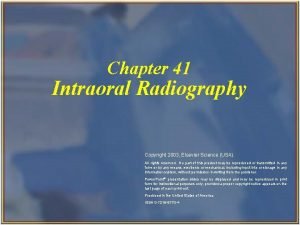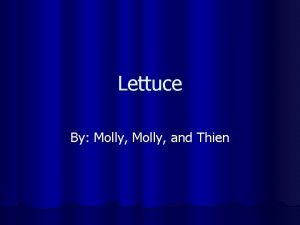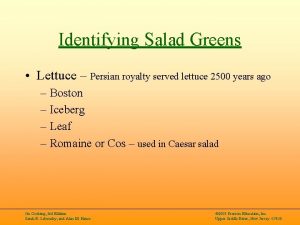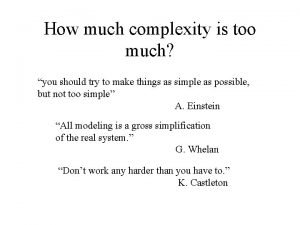Too much lettuce Someones group planted way too



















- Slides: 19

Too much lettuce… • Someone’s group planted way too many lettuce seeds in their seedling trays. • We’ll be taking some and making little self-watering planters (look to the right)

Self-Watering Planter Supplies: • • Recycled Plastic Bottle Lettuce Seedling (1 week old) String (to act as a wick) Worm Castings Regular Soil Fertilizer Tape

Building Instructions: • Remove the plastic label, and clean the inside and outside of the bottle. • Cut the bottle in half at the 2 nd ‘ring’ from the bottom. • Puncture a hole through the lid of the bottle • Pull the wick through the hole. • Add some gravel to the bottom, then dirt on top, and you’re done!

M 5 Lesson – Plant growth, Flowers / Fruit, and Tropisms. What is a tropism?


Review (Exit Slip Question) • EXIT SLIPS: WRITE YOUR ANSWER IN COMPLETE SENTENCES ON THE EXIT SLIP PAPER. NO TALKING, COPYING, CHEATING. • What is the importance of the root cap for the growth of roots through the soil?

Functions of the Root Cap • 1) Protects the delicate meristem tissue. • 2) Secretes lubricants (called mucilage) to help the root move through the soil more easily. • 3) The root cap produces hormones that guide the root downwards. Growth in response to gravity is called gravitropism. – If the root cap is removed, sometimes the root will grow in random directions. • Water / nutrients AREN’T absorbed by the root cap!

1) Fill in the Blank Notes: Root Growth Zones, Tropisms, and Flowers! • The zone of division, just above the root cap, has meristem tissue; this is where new root cells are produced. • These cells become specialized later (as part of the vascular chamber, root hairs, part of the Casparian strip, or replacing damaged cells on the root cap. ) • Water / minerals aren’t absorbed here either!

2) Further Notes: Growth Zones • The zone of elongation is where cells produced in the zone of division start to grow and elongate. This growth pushes the root downwards through the soil. • Water / minerals aren’t absorbed here either – it’s still a growth zone!

3) Zone of Differentiation / Maturation • This is where cells from the zone of elongation become specialized. • They will form the vascular cylinder, casparian strip, and other water-absorbing and transporting cells. • The root hairs are structures in the Zo. M that absorb water and minerals into the root of the plant!

4) Water movement through the plant!! • Water loss through the leaves is known as transpiration ____________, and is said to be the main driving force of water movement through the plant. As water evaporates out through the stomata _________ of the leaves, cohesive forces (water’s attraction to itself) bring water in through the root hairs!

5) Growth in response to the environment • The roots, to gain access to water, will grow in response to gravity; this is known as _______________ gravitropism (Figure 1 a). The shoot of the plant will sometimes grow against gravity, (negative gravitropism), and the root will usually grow towards the pull of gravity to dig deeper into the soil.

6) Growth in response to touch • When a plant grows in response to touch, like those in Figure 1 b, it is known as: thigmotropism _______________. • What is the purpose of a plant growing in response to touch? What type of plants would utilize this type of growth the most? _______________ Vines, creepers and other climbing plants.

Thigmonasty: the Sensitive Mimosa • As a defense mechanism, the plant leaves of Mimosa pudia, a. k. a. “sensitive mimosa, ” swell shut, to look ‘dead’ or unappetizing to predators.

ii) The Venus Fly Trap • The ‘trap’ is a modified leaf. • Special hairs on the inside act as a trigger; when more than one is touched, the trap snaps shut! • It uses water pressure to increase the size of cells along the outer edges of the leaf, and the trap closes!

Other tropisms… Growth in response to light is known as ____________. A plant growth hormone produced near the meristem in the growth regions of a plant called __________ makes this happen, as shown in Figure 2. It is released or produced in response to light, and moves to the shaded side of the shoot; this can help the plant face towards a light source by growing in that direction!

Growth in response to light: Auxin

Exit Slip Question NO TALKING, NO COPYING. BOOKS AWAY!! • 1 a) What’s the difference between thigmotropism and phototropism? Give an example of each. (2 marks) • 1 b) How could these two tropisms work together to help a plant, like a vine, survive in a dense /shaded forest. (1 mark, 1 bonus mark)

Flower Diagrams – Observation and dissection
 Too much too many and enough
Too much too many and enough How much caffeine is too much
How much caffeine is too much How much is too much plagiarism
How much is too much plagiarism Högkonjuktur inflation
Högkonjuktur inflation Planted
Planted Roy planted a vegetable garden
Roy planted a vegetable garden Planted
Planted A scientist planted seeds in 4 sections
A scientist planted seeds in 4 sections To whom much is given much is expected meaning
To whom much is given much is expected meaning So might i standing on this pleasant lea
So might i standing on this pleasant lea Oxymoron in the world is too much with us
Oxymoron in the world is too much with us The world is too much with us
The world is too much with us Megan and ron ate too much and felt sick.
Megan and ron ate too much and felt sick. Security is always excessive until it's not enough
Security is always excessive until it's not enough Basic principles of the bitewing technique include the
Basic principles of the bitewing technique include the Deacon process reaction
Deacon process reaction Romeo and juliet act 1 scene 5 summary
Romeo and juliet act 1 scene 5 summary Never too much of a good thing
Never too much of a good thing Cause and effect introduction
Cause and effect introduction Does rainwater have nitrogen
Does rainwater have nitrogen




































